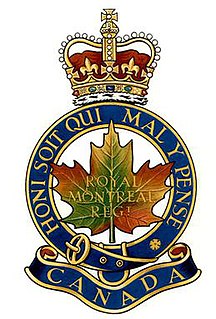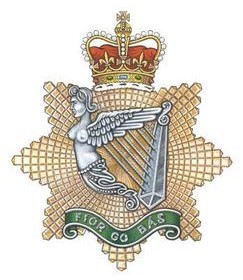Alliances
 United Kingdom - The Royal Sussex Regiment (Until 1946) [4]
United Kingdom - The Royal Sussex Regiment (Until 1946) [4]
| The New Brunswick Rangers | |
|---|---|
| Active | 1870-1946 |
| Country | Canada |
| Branch | Canadian Militia (1870-1940) Canadian Army (1940-1946) |
| Type | Line infantry |
| Role | Infantry |
| Size | One regiment |
| Part of | Non-Permanent Active Militia (1870-1940) Royal Canadian Infantry Corps (1942-1946) |
| Garrison/HQ | Sussex, New Brunswick |
| Engagements | First World War Second World War |
| Battle honours | See #Battle Honours |
The New Brunswick Rangers was an infantry regiment of the Non-Permanent Active Militia of the Canadian Militia (now the Canadian Army). In 1946, the regiment was amalgamated with The Saint John Fusiliers to form The South New Brunswick Regiment which was later renamed as The New Brunswick Scottish. They now form part of the 1st Battalion, The Royal New Brunswick Regiment. [1] [2] [3] [4]
On 12 August, 1870, the 74th Battalion of Infantry was authorized for service. The regiment had companies at Kingston, Elgin, Sussex, Shemogue, Sackville and Bay Verte, New Brunswick. [1]
On 8 May, 1900, the 74th Battalion of Infantry was reorganized and redesignated as the 74th Regiment. On 2 November, 1903, the regiment was redesignated again as the 74th Regiment The New Brunswick Rangers. [1] [6]
On 6 August 1914, Details of the 74th Regiment The New Brunswick Rangers were placed on active service for local protective duty. [2]
When the Canadian Expeditionary Force was mobilized for overseas service, the 74th New Brunswick Rangers provided volunteers to form the 12th Battalion, CEF . [2]
On 7 November 1914, the 55th Battalion (New Brunswick & Prince Edward Island), CEF was authorized for service and on 30 October 1915, the battalion embarked for Great Britain. After its arrival in the UK, the battalion provided reinforcements for the Canadian Corps in the field. On 6 July 1916, the battalion’s personnel were absorbed by the 40th Battalion (Nova Scotia), CEF. On 21 May 1917, the 55th Battalion, CEF was disbanded. [2]
On 22 December 1915, the 145th Battalion (New Brunswick), CEF was authorized for service and on 25 September 1916, the battalion embarked for Great Britain. After its arrival in the UK, on 7 October 1916, the battalion’s personnel were absorbed by the 9th Battalion, CEF to provide reinforcements for the Canadian Corps in the field. On 17 July 1917, the 145th Battalion, CEF was disbanded. [2]
On 15 July 1916, the 236th Battalion (New Brunswick Kilties), CEF was authorized for service and from between 30 October to 9 November 1917, the battalion embarked for Great Britain. After its arrival in the UK, the battalion provided reinforcements for the Canadian Corps in the field. On 13 March 1918, the battalion’s personnel were absorbed by the 20th Reserve Battalion, CEF. On 30 August 1920, the 236th Battalion, CEF was disbanded. [2]
On 1 January 1941, The New Brunswick Rangers mobilized the 1st Battalion, The New Brunswick Rangers, CASF for active service. From June 1942 to July 1943, the battalion served in Labrador in the home defence role as part of Atlantic Command. [2] [3]
On 13 September 1943, the battalion embarked for Great Britain and on 1 November 1943, was redesignated as the 10th Canadian Infantry Brigade Support Group (The New Brunswick Rangers), CIC, CASF. [2] [3]
On 24 February 1944, The New Brunswick Rangers were reorganized as the Independent Medium Machine Gun Company for the 10th Canadian Infantry Brigade and redesignated as the 10th Independent Machine Gun Company (The New Brunswick Rangers), CIC, CASF. [2] [3] [7]
On 26 July 1944, the company landed in France along with the rest of the 10th Canadian Infantry Brigade, 4th Canadian Armoured Division, and continued to fight in North-West Europe until the end of the war. On 15 February 1946, the overseas company was disbanded. [2] [3]

The Royal New Brunswick Regiment (RNBR) is a reserve infantry regiment of the Canadian Army based in New Brunswick. The Royal New Brunswick Regiment is part of 37 Canadian Brigade Group, 5th Canadian Division. The RNBR holds 65 battle honours.

The 8th Canadian Hussars is an armoured regiment in the Canadian Army. It was formed on the 4 April 1848 in New Brunswick where it has served continually ever since. Today it is a reserve armoured reconnaissance regiment with two squadrons. Its Regimental Headquarters (RHQ) and A Squadron are located in Moncton with B Squadron located in Sussex, New Brunswick.

The Royal Montreal Regiment is a Primary Reserve infantry regiment of the Canadian Army based in Westmount, Quebec. It is part of the 2nd Canadian Division's 34 Canadian Brigade Group.

The Irish Regiment of Canada is a Primary Reserve infantry regiment of the Canadian Army based in Sudbury, Ontario. It is part of the 4th Canadian Division's 33 Canadian Brigade Group. Currently one battalion of the regiment exists.
The Peel and Dufferin Regiment was an infantry regiment of the Non-Permanent Active Militia of the Canadian Militia. First organized in 1866 as the 36th Peel Battalion of Infantry, the regiment was reorganized in 1900 as the 36th Peel Regiment. Following the First World War, the regiment was reorganized again in 1920 as The Peel Regiment and for the final time in 1923 as The Peel and Dufferin Regiment. In 1936, the regiment was Amalgamated with The Lorne Rifles (Scottish) to form The Lorne Scots.

The North Shore Regiment is a Primary Reserve infantry regiment of the Canadian Army, and is part of the 5th Canadian Division's 37 Canadian Brigade Group. The regiment is headquartered in Bathurst, New Brunswick, with sub-units located in Newcastle, Campbellton and Moncton.
The Edmonton Fusiliers was an infantry regiment of the Non-Permanent Active Militia of the Canadian Militia and later the Canadian Army. First raised in 1908 as part of the 101st Regiment Edmonton Fusiliers, it became a separate regiment in 1924 when The Edmonton Regiment was split into two separate regiments. In 1946, the regiment was Amalgamated with the 19th Alberta Dragoons.
The Carleton and York Regiment was an infantry regiment of the Non-Permanent Active Militia of the Canadian Militia. In 1954, the regiment was amalgamated with The New Brunswick Scottish and The North Shore Regiment to form the 2 battalions of The New Brunswick Regiment.
The Lanark and Renfrew Scottish Regiment was an infantry regiment of the Non-Permanent Active Militia of the Canadian Militia and later the Canadian Army. First organized as the 42nd Brockville Battalion of Infantry in 1866, the regiment was later relocated to Pembroke, Ontario and Redesignated as the 42nd Lanark and Renfrew Battalion of Infantry and became a Scottish regiment in 1927. The regiment was first converted to an air defence artillery regiment in 1946 but converted back to an infantry regiment in 1959. In 1992, the regiment was again converted to artillery as the 1st Air Defence Regiment, RCA.
The Oxford Rifles were an infantry regiment of the Non-Permanent Active Militia of the Canadian Militia. In 1954, the regiment was amalgamated with The Canadian Fusiliers to form The London and Oxford Fusiliers.
The Irish Canadian Rangers were an infantry regiment of the Non-Permanent Active Militia of the Canadian Militia. In 1936, the regiment was disbanded as a result of a country wide reorganization of the Canadian Militia.
The Victoria and Haliburton Regiment was an infantry regiment of the Non-Permanent Active Militia of the Canadian Militia. In 1936, the regiment was Converted from Infantry to Artillery to become the 45th Field Battery RCA and now forms part of the 50th Field Artillery Regiment, RCA.
The Kenora Light Infantry was an infantry regiment of the Non-Permanent Active Militia of the Canadian Militia. In 1936, the regiment was converted to artillery.
The Manitoba Rangers was an infantry regiment of the Non-Permanent Active Militia of the Canadian Militia. In 1936, the regiment was converted to artillery and now exists as the 26th Field Artillery Regiment, RCA.
The York Rangers was an infantry regiment of the Non-Permanent Active Militia of the Canadian Militia. Although the unit was first officially created in 1866, the regiment traces its ancestry and origins as far back to Roger's Rangers of the Seven Years War, the Queen's Rangers of the American Revolutionary War and also the York Militia of the War of 1812. In 1936, the regiment was Amalgamated with The Queen's Rangers to form The Queen's York Rangers.
The Saint John Fusiliers was an infantry regiment of the Non-Permanent Active Militia of the Canadian Militia. In 1946, the regiment was amalgamated with The New Brunswick Rangers to form the South New Brunswick Regiment which was later renamed as The New Brunswick Scottish. They now form part of the 1st Battalion, The Royal New Brunswick Regiment.
The Carleton Light Infantry was an infantry regiment of the Non-Permanent Active Militia of the Canadian Militia. In 1936, the regiment was Amalgamated with The York Regiment to form The Carleton and York Regiment.
The Middlesex and Huron Regiment was an infantry regiment of the Non-Permanent Active Militia of the Canadian Militia. It was formed in 1936, as a result of the Amalgamation of The Middlesex Light Infantry and The Huron Regiment. In 1946, the regiment was disbanded.
The Midland Regiment was an infantry regiment of the Non-Permanent Active Militia of the Canadian Militia and later the Canadian Army. The regiment was formed in 1936 by the Amalgamation of The Northumberland Regiment and The Durham Regiment. In 1954, The Midland Regiment was Amalgamated into The Hastings and Prince Edward Regiment.
The Lincoln Regiment was an infantry regiment of the Non-Permanent Active Militia of the Canadian Militia. In 1936, the regiment was Amalgamated with The Lincoln and Welland Regiment to form a new regiment also named The Lincoln and Welland Regiment.